Botao Yu
Tooling or Not Tooling? The Impact of Tools on Language Agents for Chemistry Problem Solving
Nov 11, 2024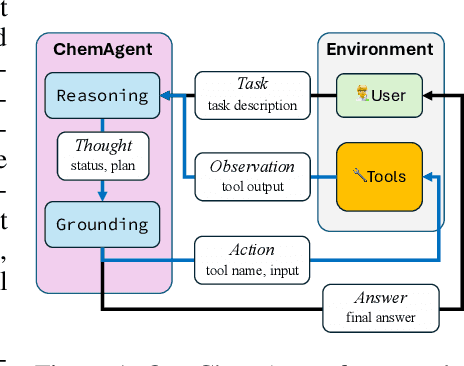



Abstract:To enhance large language models (LLMs) for chemistry problem solving, several LLM-based agents augmented with tools have been proposed, such as ChemCrow and Coscientist. However, their evaluations are narrow in scope, leaving a large gap in understanding the benefits of tools across diverse chemistry tasks. To bridge this gap, we develop ChemAgent, an enhanced chemistry agent over ChemCrow, and conduct a comprehensive evaluation of its performance on both specialized chemistry tasks and general chemistry questions. Surprisingly, ChemAgent does not consistently outperform its base LLMs without tools. Our error analysis with a chemistry expert suggests that: For specialized chemistry tasks, such as synthesis prediction, we should augment agents with specialized tools; however, for general chemistry questions like those in exams, agents' ability to reason correctly with chemistry knowledge matters more, and tool augmentation does not always help.
ScienceAgentBench: Toward Rigorous Assessment of Language Agents for Data-Driven Scientific Discovery
Oct 07, 2024



Abstract:The advancements of language language models (LLMs) have piqued growing interest in developing LLM-based language agents to automate scientific discovery end-to-end, which has sparked both excitement and skepticism about the true capabilities of such agents. In this work, we argue that for an agent to fully automate scientific discovery, it must be able to complete all essential tasks in the workflow. Thus, we call for rigorous assessment of agents on individual tasks in a scientific workflow before making bold claims on end-to-end automation. To this end, we present ScienceAgentBench, a new benchmark for evaluating language agents for data-driven scientific discovery. To ensure the scientific authenticity and real-world relevance of our benchmark, we extract 102 tasks from 44 peer-reviewed publications in four disciplines and engage nine subject matter experts to validate them. We unify the target output for every task to a self-contained Python program file and employ an array of evaluation metrics to examine the generated programs, execution results, and costs. Each task goes through multiple rounds of manual validation by annotators and subject matter experts to ensure its annotation quality and scientific plausibility. We also propose two effective strategies to mitigate data contamination concerns. Using our benchmark, we evaluate five open-weight and proprietary LLMs, each with three frameworks: direct prompting, OpenHands, and self-debug. Given three attempts for each task, the best-performing agent can only solve 32.4% of the tasks independently and 34.3% with expert-provided knowledge. These results underscore the limited capacities of current language agents in generating code for data-driven discovery, let alone end-to-end automation for scientific research.
MMMU-Pro: A More Robust Multi-discipline Multimodal Understanding Benchmark
Sep 04, 2024



Abstract:This paper introduces MMMU-Pro, a robust version of the Massive Multi-discipline Multimodal Understanding and Reasoning (MMMU) benchmark. MMMU-Pro rigorously assesses multimodal models' true understanding and reasoning capabilities through a three-step process based on MMMU: (1) filtering out questions answerable by text-only models, (2) augmenting candidate options, and (3) introducing a vision-only input setting where questions are embedded within images. This setting challenges AI to truly "see" and "read" simultaneously, testing a fundamental human cognitive skill of seamlessly integrating visual and textual information. Results show that model performance is substantially lower on MMMU-Pro than on MMMU, ranging from 16.8% to 26.9% across models. We explore the impact of OCR prompts and Chain of Thought (CoT) reasoning, finding that OCR prompts have minimal effect while CoT generally improves performance. MMMU-Pro provides a more rigorous evaluation tool, closely mimicking real-world scenarios and offering valuable directions for future research in multimodal AI.
LlaSMol: Advancing Large Language Models for Chemistry with a Large-Scale, Comprehensive, High-Quality Instruction Tuning Dataset
Feb 17, 2024



Abstract:Chemistry plays a crucial role in many domains, such as drug discovery and material science. While large language models (LLMs) such as GPT-4 exhibit remarkable capabilities on natural language processing tasks, existing work shows their performance on chemistry tasks is discouragingly low. In this paper, however, we demonstrate that our developed LLMs can achieve very strong results on a comprehensive set of chemistry tasks, outperforming the most advanced GPT-4 across all the tasks by a substantial margin and approaching the SoTA task-specific models. The key to our success is a large-scale, comprehensive, high-quality dataset for instruction tuning named SMolInstruct. It contains 14 meticulously selected chemistry tasks and over three million high-quality samples, laying a solid foundation for training and evaluating LLMs for chemistry. Based on SMolInstruct, we fine-tune a set of open-source LLMs, among which, we find that Mistral serves as the best base model for chemistry tasks. We further conduct analysis on the impact of trainable parameters, providing insights for future research.
MMMU: A Massive Multi-discipline Multimodal Understanding and Reasoning Benchmark for Expert AGI
Nov 27, 2023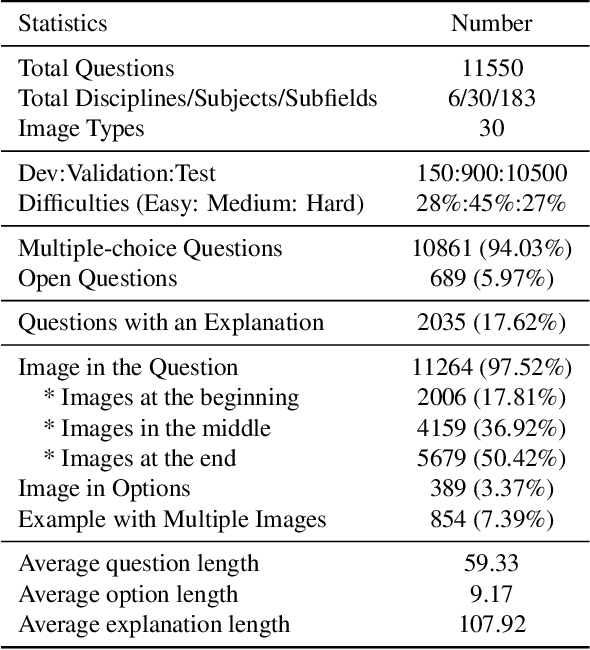
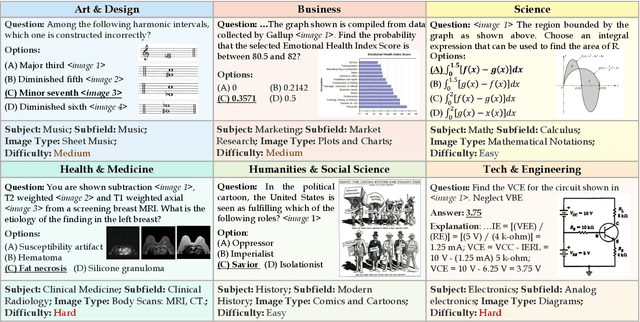
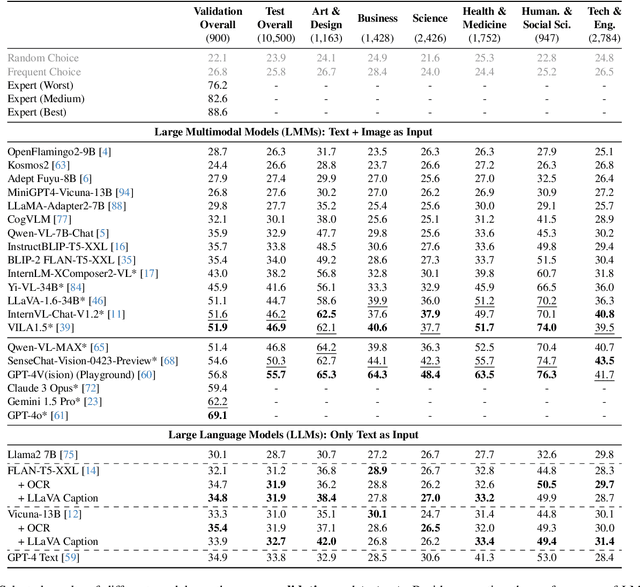

Abstract:We introduce MMMU: a new benchmark designed to evaluate multimodal models on massive multi-discipline tasks demanding college-level subject knowledge and deliberate reasoning. MMMU includes 11.5K meticulously collected multimodal questions from college exams, quizzes, and textbooks, covering six core disciplines: Art & Design, Business, Science, Health & Medicine, Humanities & Social Science, and Tech & Engineering. These questions span 30 subjects and 183 subfields, comprising 30 highly heterogeneous image types, such as charts, diagrams, maps, tables, music sheets, and chemical structures. Unlike existing benchmarks, MMMU focuses on advanced perception and reasoning with domain-specific knowledge, challenging models to perform tasks akin to those faced by experts. Our evaluation of 14 open-source LMMs and the proprietary GPT-4V(ision) highlights the substantial challenges posed by MMMU. Even the advanced GPT-4V only achieves a 56% accuracy, indicating significant room for improvement. We believe MMMU will stimulate the community to build next-generation multimodal foundation models towards expert artificial general intelligence.
EmoGen: Eliminating Subjective Bias in Emotional Music Generation
Jul 03, 2023Abstract:Music is used to convey emotions, and thus generating emotional music is important in automatic music generation. Previous work on emotional music generation directly uses annotated emotion labels as control signals, which suffers from subjective bias: different people may annotate different emotions on the same music, and one person may feel different emotions under different situations. Therefore, directly mapping emotion labels to music sequences in an end-to-end way would confuse the learning process and hinder the model from generating music with general emotions. In this paper, we propose EmoGen, an emotional music generation system that leverages a set of emotion-related music attributes as the bridge between emotion and music, and divides the generation into two stages: emotion-to-attribute mapping with supervised clustering, and attribute-to-music generation with self-supervised learning. Both stages are beneficial: in the first stage, the attribute values around the clustering center represent the general emotions of these samples, which help eliminate the impacts of the subjective bias of emotion labels; in the second stage, the generation is completely disentangled from emotion labels and thus free from the subjective bias. Both subjective and objective evaluations show that EmoGen outperforms previous methods on emotion control accuracy and music quality respectively, which demonstrate our superiority in generating emotional music. Music samples generated by EmoGen are available via this link:https://ai-muzic.github.io/emogen/, and the code is available at this link:https://github.com/microsoft/muzic/.
MuseCoco: Generating Symbolic Music from Text
May 31, 2023



Abstract:Generating music from text descriptions is a user-friendly mode since the text is a relatively easy interface for user engagement. While some approaches utilize texts to control music audio generation, editing musical elements in generated audio is challenging for users. In contrast, symbolic music offers ease of editing, making it more accessible for users to manipulate specific musical elements. In this paper, we propose MuseCoco, which generates symbolic music from text descriptions with musical attributes as the bridge to break down the task into text-to-attribute understanding and attribute-to-music generation stages. MuseCoCo stands for Music Composition Copilot that empowers musicians to generate music directly from given text descriptions, offering a significant improvement in efficiency compared to creating music entirely from scratch. The system has two main advantages: Firstly, it is data efficient. In the attribute-to-music generation stage, the attributes can be directly extracted from music sequences, making the model training self-supervised. In the text-to-attribute understanding stage, the text is synthesized and refined by ChatGPT based on the defined attribute templates. Secondly, the system can achieve precise control with specific attributes in text descriptions and offers multiple control options through attribute-conditioned or text-conditioned approaches. MuseCoco outperforms baseline systems in terms of musicality, controllability, and overall score by at least 1.27, 1.08, and 1.32 respectively. Besides, there is a notable enhancement of about 20% in objective control accuracy. In addition, we have developed a robust large-scale model with 1.2 billion parameters, showcasing exceptional controllability and musicality.
Museformer: Transformer with Fine- and Coarse-Grained Attention for Music Generation
Oct 19, 2022
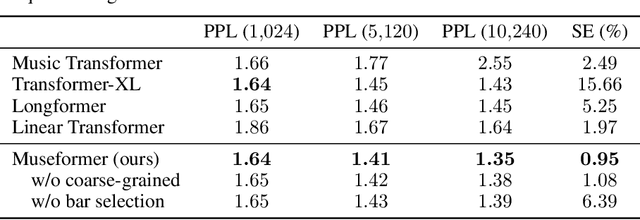
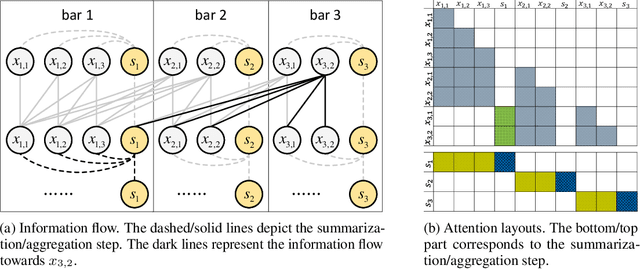

Abstract:Symbolic music generation aims to generate music scores automatically. A recent trend is to use Transformer or its variants in music generation, which is, however, suboptimal, because the full attention cannot efficiently model the typically long music sequences (e.g., over 10,000 tokens), and the existing models have shortcomings in generating musical repetition structures. In this paper, we propose Museformer, a Transformer with a novel fine- and coarse-grained attention for music generation. Specifically, with the fine-grained attention, a token of a specific bar directly attends to all the tokens of the bars that are most relevant to music structures (e.g., the previous 1st, 2nd, 4th and 8th bars, selected via similarity statistics); with the coarse-grained attention, a token only attends to the summarization of the other bars rather than each token of them so as to reduce the computational cost. The advantages are two-fold. First, it can capture both music structure-related correlations via the fine-grained attention, and other contextual information via the coarse-grained attention. Second, it is efficient and can model over 3X longer music sequences compared to its full-attention counterpart. Both objective and subjective experimental results demonstrate its ability to generate long music sequences with high quality and better structures.
MeloForm: Generating Melody with Musical Form based on Expert Systems and Neural Networks
Aug 30, 2022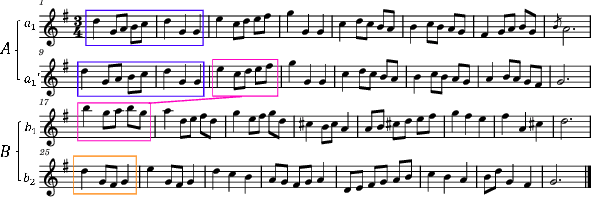

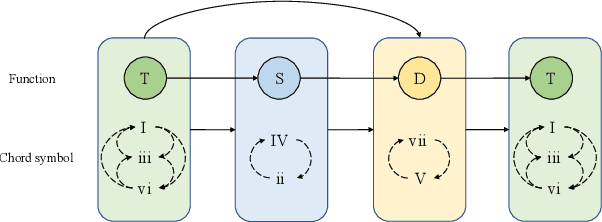
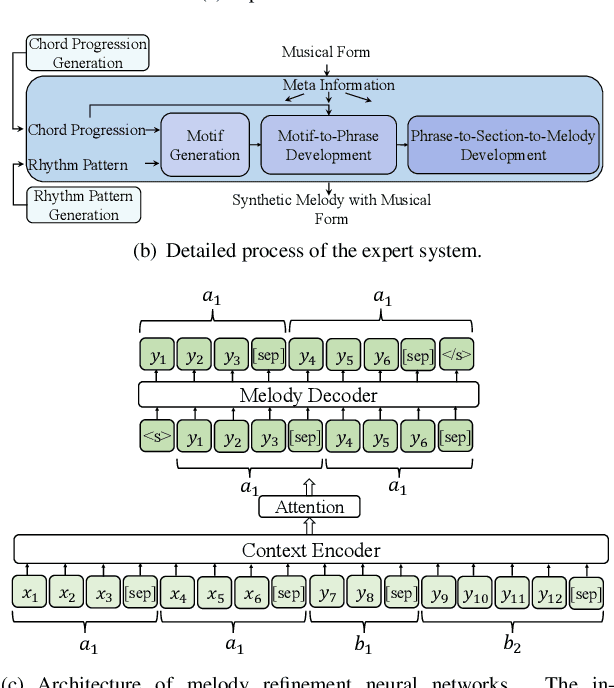
Abstract:Human usually composes music by organizing elements according to the musical form to express music ideas. However, for neural network-based music generation, it is difficult to do so due to the lack of labelled data on musical form. In this paper, we develop MeloForm, a system that generates melody with musical form using expert systems and neural networks. Specifically, 1) we design an expert system to generate a melody by developing musical elements from motifs to phrases then to sections with repetitions and variations according to pre-given musical form; 2) considering the generated melody is lack of musical richness, we design a Transformer based refinement model to improve the melody without changing its musical form. MeloForm enjoys the advantages of precise musical form control by expert systems and musical richness learning via neural models. Both subjective and objective experimental evaluations demonstrate that MeloForm generates melodies with precise musical form control with 97.79% accuracy, and outperforms baseline systems in terms of subjective evaluation score by 0.75, 0.50, 0.86 and 0.89 in structure, thematic, richness and overall quality, without any labelled musical form data. Besides, MeloForm can support various kinds of forms, such as verse and chorus form, rondo form, variational form, sonata form, etc.
Knowing False Negatives: An Adversarial Training Method for Distantly Supervised Relation Extraction
Sep 05, 2021



Abstract:Distantly supervised relation extraction (RE) automatically aligns unstructured text with relation instances in a knowledge base (KB). Due to the incompleteness of current KBs, sentences implying certain relations may be annotated as N/A instances, which causes the so-called false negative (FN) problem. Current RE methods usually overlook this problem, inducing improper biases in both training and testing procedures. To address this issue, we propose a two-stage approach. First, it finds out possible FN samples by heuristically leveraging the memory mechanism of deep neural networks. Then, it aligns those unlabeled data with the training data into a unified feature space by adversarial training to assign pseudo labels and further utilize the information contained in them. Experiments on two wildly-used benchmark datasets demonstrate the effectiveness of our approach.
 Add to Chrome
Add to Chrome Add to Firefox
Add to Firefox Add to Edge
Add to Edge